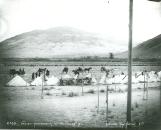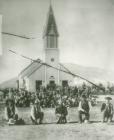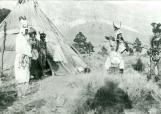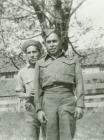1
Several aspects of war are relevent in the Secwepemc history. The pre-contact era where the Secwepemc would war amongst themselves or with other invading Tribes such as Okanagan, Coastal Salish, Chilcootin or Plains. Such wars were over land, supplies, families or slavery and were often resulted with a deadly battle. Later in time during the contact of white man, Secwepemc were constantly confronted with the government and church's attempts at genocidal war. This type of warfare is not documented by the Federal or Provincial governments and most likely has been erased from record or considered confidential. To the Secwepemc this genocidal war still exists to this day but is battled out through political will and legal dispute.2
Traditional clothing20th Century
Kamloops, British Columbia, Canada
 Credits:
Credits:BC Provincial Museum and Archives
4
One man is holding a spear and the rest looking on, by a teepee in the Barnhartville area. The Secwepemc were known to go to war over slavery, territory and trade items.5
Indian Possession20th Century
Kamloops, British Columbia, Canada
 Credits:
Credits:BC Provincial Museum and Archives
6
Tents set up towards the front where people are either on horses, on wagons or standing in back ground there is people standing in a long line. Part of military and religious genocide of Secwepemc.7
Many Indian People attending St. Josephs Church20th Century
Kamloops, British Columbia, Canada
 Credits:
Credits:BC Provincial Museum and Archives



